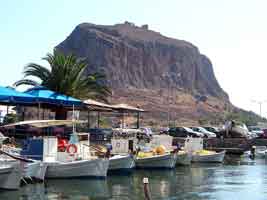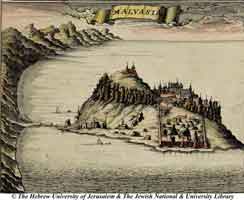.
Administrative Region : Peloponnese
Regional unit : Lakonia
Monemvasia (Greek: Μονεμβασιά) is a town and a municipality in Laconia, Greece. The town is located on a small peninsula off the east coast of the Peloponnese. The peninsula is linked to the mainland by a short causeway 200m in length. Its area consists mostly of a large plateau some 100 metres above sea level, up to 300 m wide and 1 km long, the site of a powerful medieval fortress. The town walls and many Byzantine churches remain from the mediaeval period. The seat of the municipality is the town Molaoi.[1]
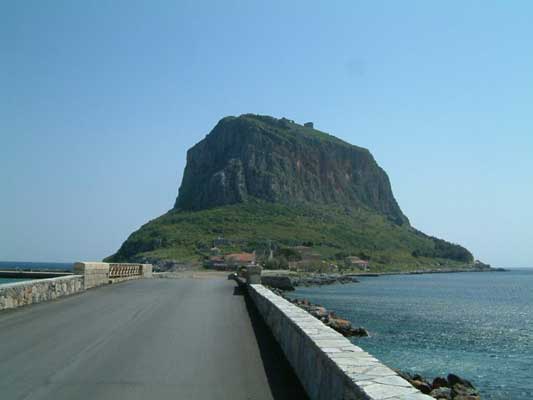
Monemvasia can be seen in the background
The town's name derives from two Greek words, mone and emvasia, meaning "single entrance". Its Italian form, Malvasia, gave its name to Malmsey wine. Monemvasia's nickname is the Gibraltar of the East or The Rock.
Geography
The town is built on the slope to the south-east of the rock, overlooking Palaia Monemvasia bay. Many of the streets are narrow and fit only for pedestrians. A small hamlet of about 10 houses lies to the northwest.
Municipality
The municipality Monemvasia was formed at the 2011 local government reform by the merger of the following 5 former municipalities, that became municipal units:[1]
Elos
Molaoi
Monemvasia
Voies
Zarakas
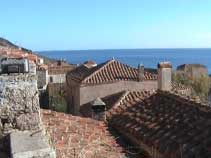
The town of Monemvasia as it appears today
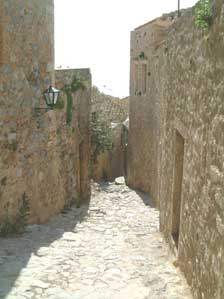
The town was liberated from Ottoman rule on August 1, 1821, during the Greek War of Independence.
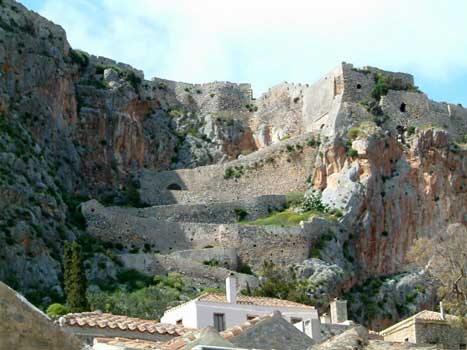
Citadel
History
Middle Ages
Map made by F. de Witt, Amsterdam, 1680.
Street of Monemvasia.
The town and fortress were founded in 583 by people seeking refuge from the Slavic and the Avaric invasion of Greece. A history of the invasion and occupation of the Peloponnese was recorded in the medieval Chronicle of Monemvasia.
From the 10th century AD, the town developed into an important trade and maritime centre. The fortress withstood the Arab and Norman invasions in 1147; cornfields that fed up to 30 men were tilled inside the fortress. William II of Villehardouin took it in 1248, on honourable terms, after three years of siege; in 1259 William was captured by the Greeks after the battle of Pelagonia and in 1262 it was retroceded to Michael VIII Palaiologos as part of William's ransom.
It remained part of the Byzantine Empire until 1460, becoming the seat of an Imperial governor, a landing place for Imperial operations against the Franks, the main port of shipment (if not always production) for Malmsey wine, and one of the most dangerous lairs of corsairs in the Levant. The Emperors gave it valuable privileges, attracting Roger de Lluria who sacked the lower town in 1292. The town welcomed the Catalan Company on its way eastward in 1302. In 1397 Theodore I Palaiologos deposed the local dynast of Monemvasia, who appealed to Sultan Bayezid I and was reinstated by Turkish troops. In 1419 the rock appears to have come into the possession of Venice, though it soon returned to the Despot. About 1401, the historian George Sphrantzes was born in the town. After the fall of Constantinople Monemvasia held out against the threats of Sultan Mehmed II in 1458 and 1460, when it became the only remaining domain of the Despot of Morea, Thomas Palaiologos, claimant of the Imperial throne. He had no forces to defend it; he offered it to the Sultan, and finally sold it to the Pope.[2]
By 1464 the inhabitants found the Pope's representative feeble and the Pope unable to protect them; they admitted a Venetian garrison. The town was fairly prosperous under Venetian rule until the peace of 1502-3, in which it lost its farm lands, source of its food supply and of Malmsey wine. The food had to come by sea or from Turkish-held lands, and the cultivation of wine languished under Turkish rule. The rock was governed by Venetians until the treaty of 1540, which cost the Republic Nauplia and Monemvasia, her last two possessions on mainland Greece. Those inhabitants who did not wish to live under Turkish rule were given lands elsewhere.[3] The Ottomans then ruled the town until the brief Venetian recovery from 1690, then again from 1715 to 1821. It was known as "Menekşe" ("Violet" in Turkish) during Ottoman rule and was a sanjak centre in Mora province.
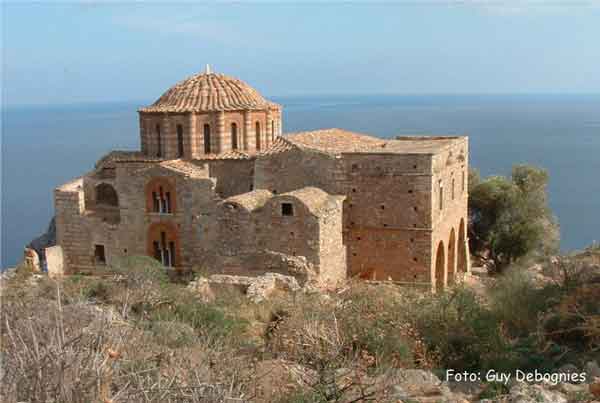
Hagia Sophia Church build end of 12th century under the order of the Byzantine Emperor Andronicus, transformed into a cathedral and into a Mosque, the frescoes covered with lime [Source]
The commercial importance of the town continued until the Orlov Revolt (1770) in the Russo-Turkish War, which saw its importance decline severely.
Modern times
The town was liberated from Ottoman rule on July 23, 1821 by Tzannetakis Grigorakis who entered the town with his private army during the Greek War of Independence. The "liberation" was followed by a massacre of many of its Turkish inhabitants.
In 1971, Monemvasia became linked with the rest of the outside world through a bridge on the western side that connects to GR-86.
In more recent history, the town has seen a resurgence in importance with increasing numbers of tourists visiting the site and the region. The medieval buildings have been restored, and many of them converted to hotels.
Places of interest
The Church of Ayia Sophia
Christos Elkomenos Square
Historical population
Year Village Municipality
1971 32 -
1991 78 3,950
2001 90 4,660
Division of the municipality
Monemvasia / Τ.δ. Μονεμβασίας [ 1.405 ]
- Monemvasia / η Μονεμβασία [ 90 ]
- Agia Kyriaki / η Αγία Κυριακή [ 84 ]
- Gefyra / η Γέφυρα [ 1.231 ]
Angelona / Τ.δ. Αγγελώνας -- η Αγγελώνα [ 518 ]
Agios Dimitrios Monemvasias / Τ.δ. Αγίου Δημητρίου Μονεμβασίας [ 317 ]
- Agios Dimitrios / ο Άγιος Δημήτριος [ 240 ]
- Floka / η Φλόκα [ 77 ]
Agios Ioannis Epidavrou Limiras / Τ.δ. Αγίου Ιωάννου Επιδαύρου Λιμήρας -- ο Άγιος Ιωάννης [ 557 ]
Agios Nikolaso Monemvasias / Τ.δ. Αγίου Νικολάου Μονεμβασίας -- ο Άγιος Νικόλαος [ 188 ]
Velies / Τ.δ. Βελιών -- οι Βελιές [ 494 ]
Elliniko / Τ.δ. Ελληνικού [ 315 ]
- Elliniko / το Ελληνικόν [ 177 ]
- Panagitsa /η Παναγίτσα [ 15 ]
- Foutia / τα Φούτια [ 123 ]
Lira / Τ.δ. Λιρών [ 280 ]
Nomia / Τ.δ. Νομίων [ 367 ]
- Nomia / τα Νόμια [ 47 ]
- Agia Paraskevi / η Αγία Παρασκευή [ 84 ]
- Agios Stefanos / ο Άγιος Στέφανος [ 55 ]
- Agios Fokas / ο Άγιος Φωκάς [ 50 ]
- Fokas / η Καστέλλα [ 7 ]
- Xifias / ο Ξιφίας [ 91 ]
- Trochalia / η Τροχαλία [ 33 ]
Talanta / Τ.δ. Ταλάντων [ 219 ]
- Talanta / τα Τάλαντα [ 197 ]
- Klironomeika / τα Κληρονομαίικα [ 22 ]
Notable people
Yiannis Ritsos (1909-1990) poet
Greece :
A - B - C - D - E - F - G - H - I - J - K - L - M -
N - O - P - Q - R - S - T - U - V - W - X - Y - Z
| Ancient Greece
Science, Technology , Medicine , Warfare, , Biographies , Life , Cities/Places/Maps , Arts , Literature , Philosophy ,Olympics, Mythology , History , Images Medieval Greece / Byzantine Empire Science, Technology, Arts, , Warfare , Literature, Biographies, Icons, History Modern Greece Cities, Islands, Regions, Fauna/Flora ,Biographies , History , Warfare, Science/Technology, Literature, Music , Arts , Film/Actors , Sport , Fashion --- |
Retrieved from "http://en.wikipedia.org/"
All text is available under the terms of the GNU Free Documentation License


